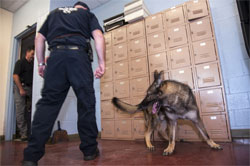ALERT researchers work to develop robust Canine Training Aids
Because of their volatility, explosives are rarely used pure, they are often mixed with other materials such as polymers. Explosives are exposed to polymers for a variety of reason: (1) when they are “plasticized” for shaping; (2) when they are encased for safe handling, (e.g. dog training aids); and (3) when they are collected for forensic evidence or storage. ALERT has focused on finding the best materials for developing devices such as these.
As a result of our study of polymer/HME interactions, ALERT researchers have developed a method of polymer encapsulation that is used to create safe trace explosive sources for canine and instrument training. Polycarbonate microspheres containing only a low percentage of TATP have been demonstrated to last for years, yet produce pure TATP vapor when heated at the designated program rate. This approach provides canine handlers and instrument vendors with safe access to stored hazardous explosives at trace levels for use in detection, calibration, and validation of instruments as well and the training of explosives detecting canines.
ALERT has received enthusiastic support from law enforcement and instrument vendors and are in negotiation for possible licensing with a commercial vendor. In the near term, law enforcement agencies and instrument vendors are able to request these training aids directly from ALERT.
Oxley said “Some of our biggest service clients are law enforcement agencies. When some of the improvised devices came into vogue, they were too sensitive for law enforcement agencies to handle.” Oxley explained that for the Popular Science crew, her team not only conducted a demonstration, but ran a test to determine if the dogs detect pseudo explosives as they do the real explosives.
“It worked and we were really excited, because this was a first-time run during which the dogs were testing both,” said the chemistry professor and co-coordinator of the URI Forensic Science Partnership. “We wanted to make sure they could associate one with the other; that was an extremely important task.
“With K-9s, we are looking at the odor signature, and we have to do that on an explosive-by-explosive basis,” she said.She added that Metropolitan Transit Authority police took advantage of training opportunities at URI long before other groups, but more and more agencies are seeking training, including the federal Transportation Security Administration, which has rotated dozens of agents through the URI campus this summer.
Photo caption: Sgt. Bill Finucane of the Metropolitan Transportation Authority Police Department in New York works with McCarney, one of the department’s dogs, while testing canine explosive training aids developed by URI’s Jimmie Oxley and her team.

Innovation Fast Track
EXCLUSIVE TO CENTER MEMBERS: Log in to explore your Innovation Fast Track, an online portal that gives you one-stop access to center researchers, funding opportunities, exclusive events and more.
Learn MoreStudent Central
Students, get connected with Industry Partners, find out about research and volunteer opportunities within ALERT, or get advice on how to best showcase your work at Student Central.
Learn MoreThe Partnership
ALERT is led by Northeastern University (NEU) and includes three key academic strategic partners: Boston University, Purdue University, and University of Rhode Island (URI).
Learn More